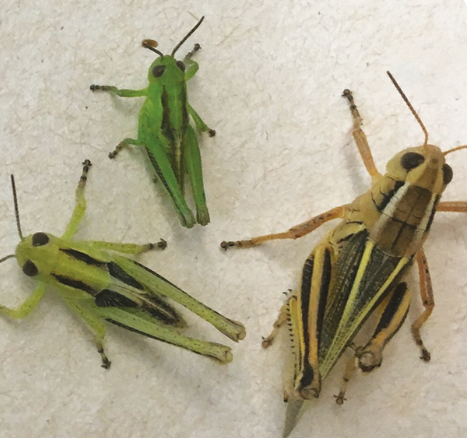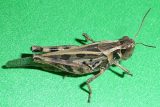Pest Species in Manitoba
There are 85 grasshopper species in Manitoba, but only four have the potential to become crop pests, including the migratory, twostriped, clearwinged and packard grasshoppers. These species are not to be confused with katydids and leafhoppers, which are also commonly found in Manitoba. And not all of these pest species feed on beans.
- Migratory grasshopper – Feeds on both grasses and broadleaf plants, along with dried material on the ground. At high populations, they start moving as a group.
- Twostriped grasshopper – Feeds on grasses and broadleaves, but prefers broadleaf plants. Also feeds on dry litter on the ground. These eggs hatch about 8-10 days before the migratory grasshopper eggs. It takes about 40 days for the nymphs to develop into adults.
- Clearwinged grasshopper – Primarily a grass feeder and seldom feeds on broadleaf plants.
- Packard grasshopper – Feeds on grass and broadleaf plants, but reportedly prefers legumes.
Adapted from the Manitoba Agriculture and Resource Development web page by John Gavloski, Grasshoppers: Identification, Monitoring and Management.
Life Cycle

Grasshopper eggs are laid in the soil from late July through the fall. Egg hatching begins when soil temperature reaches 15-16°C for about 200 hours. Warm, dry conditions are conducive to egg laying and hatching.
Nymphs are newly-hatched grasshoppers that are a miniature version of the adult grasshopper. These nymphs mature in 35-55 days. They move through five nymph stages, or instars, before turning into adults. The adult phase occurs about a week after the fifth instar, which is when the wing bud is extended and starting to look like a wing. The four pest species have one generation per year on the Canadian prairies.
Action Thresholds
- Grasshoppers are difficult to count in the field, but if you are seeing 8-12 grasshoppers per square metre, control is usually warranted.
- Defoliation thresholds may be easier to follow. Assess defoliation on two random plants within five different areas of the field for an accurate estimate. For soybeans and dry beans, the threshold is 30% defoliation pre-bloom, 15% from bloom to pod fill and 25% from pod fill to maturity, unless pod feeding is observed. Low levels of defoliation will not cause economical yield loss.
- Sweep net sampling is not recommended for assessing populations but is useful for identifying the development stage of grasshoppers for treatment timing.

Management
Grasshopper populations are typically concentrated along roadsides and field edges, so a border spray may be all that is needed.
The best time to control grasshoppers is after most have hatched and before most have turned into adults. This coincides with the third to fourth instars. They can still be controlled at the adult stage, but it becomes more difficult, as they can fly and disperse more easily, and some insecticides do not work as well on adults. Higher rates of insecticide may be needed at the adult stage, along with application over a greater area, meaning control also becomes more expensive.
Consider beneficial insects in your grasshopper management decisions. Ground beetles, crickets, larvae of blister beetles and bee flies are all predators that feed on grasshopper eggs. Spiders, robber flies, some wasps, and different types of birds and rodents will feed on grasshopper nymphs and adults. There are also parasitoids and pathogens that can help control grasshopper populations. Pollinators should also be considered. Although they do not prey on grasshoppers, they do provide a service to the immediate or surrounding flowering crops. If a crop must be sprayed at the flowering stage, apply as late in the day as possible and choose an insecticide that is not harmful to pollinators (e.g., Coragen).


